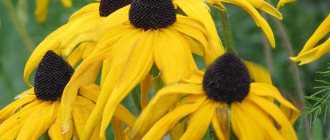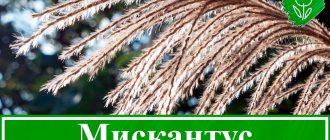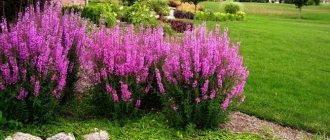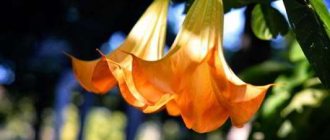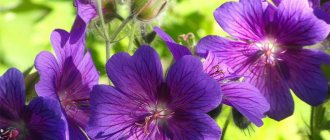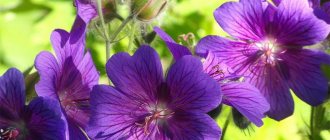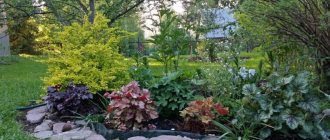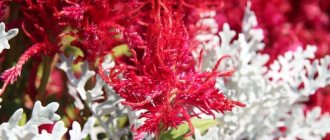The gentian plant (Gentiana), which is part of the Gentian family, is represented by herbaceous annuals or perennials, as well as subshrubs. This genus includes approximately 400 species. Under natural conditions, such a plant can be found on any continent of the Earth, but most often it is found in the temperate climate zone of the Northern Hemisphere, for example, in subalpine and alpine meadows. Some species can be found at an altitude of about 5.5 thousand meters above sea level.
Already in Ancient Egypt, gentian began to be used as a highly effective remedy for stomach diseases. Moreover, in Ancient Rome it was used to treat bruises, cramps and bites of poisonous animals. In the Middle Ages, the herb of this plant was used for diarrhea, plague, tuberculosis, fever, and also to get rid of worms. And today such a culture is very valuable among healers living in the Carpathians; they use it to treat diseases of the gallbladder, liver and digestive organs. According to Pliny the Elder, the Latin name of the genus was given in honor of the Illyrian king Gentius, who treated the plague with the rhizome of yellow gentian. This culture received its Russian name due to the bitter taste of the rhizomes and foliage, which contain medicinal substances such as glycosides.
Description of the plant
Gentian (Gentiana L.) is a genus of herbaceous plants from the Gentian family. The genus includes 360-400 species found throughout the world, mainly in temperate climates and mountainous regions.
There are 29 species growing in Europe, more than 300 in Asia, several species are found in North America, the Andes, southern Africa, and New Zealand. These plants inhabit mountain meadows, rocky places, swamps, and light forests.
The origin of the scientific name Gentiana is associated with the name of Gentios, the king of Illyria (2nd century BC), who is credited with discovering the healing properties of the plant, which he used to treat the plague. Plants have medicinal uses, in particular yellow gentian is known, also used to color liqueurs.
Botanical characteristics:
- Form . Mostly rhizomatous perennials, less often annual or biennial. Usually low plants, but there are species reaching 1.5 m.
- Leaves are opposite, sessile, usually glabrous, entire.
- The flowers are large, usually five-membered, with a tubular, bell-shaped or funnel-shaped crown of different colors. The petals are twisted in the bud. There are 5 stamens, the anthers are large. The superior ovary is two-chambered. A characteristic feature that distinguishes gentian flowers from other genera of the family is the presence of growths in the crown between the petals.
- The fruit is a capsule containing several seeds, which opens with two doors. The seeds are small, often winged.
Plants grow in the European part of Russia, the Caucasus, Siberia, and the Urals. Like most mountain plants, they are well suited for rock gardens and forest gardens.
Most gentian species are frost-resistant perennials. Less commonly, annual or biennial plants. Among them there are specimens reaching several centimeters and varieties 1 meter high. They can form small bushes or extensive carpets. The flowering period of gentian is spring, late summer, autumn, depending on the species. Only a few will fill the gap and bloom in midsummer.
All species have large, tubular, bell-shaped flowers. More often they are blue, there are white, yellow, purple, red, green. Flowers grow on shoots singly or in inflorescences.
Blue flowers are very readily visited by bees.
The genus owes its name to the bitter substances contained in the leaves and roots. In large quantities, these substances are poisonous. Their extracts are used to produce medicines that stimulate appetite, improve digestion, and stimulate the production of digestive juices. Gentian preparations are useful for intestinal inflammation, dyspepsia, heartburn, liver and spleen dysfunction.
Medicinal properties
The rhizome and shoots of gentian contain many alkaloids, glycosides and other biologically active substances. Due to this, the plant has long been used in folk medicine, and is also used for the preparation of pharmaceuticals. Decoctions and preparations based on gentian have a high choleretic, expectorant, anti-inflammatory, and stimulating effect.
Gentian is used to combat such ailments as:
- cough;
- convulsions;
- arthritis;
- scurvy;
- diarrhea;
- flatulence;
- anemia;
- fever.
It is important not to overuse gentian medications. An overdose leads to increased blood pressure, excitability, and dizziness.
Types and varieties
Gentians are a large, very diverse group of plants. The genus includes about 400 species. Individual species vary considerably, especially in terms of habitat requirements. To grow these plants in the garden successfully, it is necessary to know what species (or varieties) we are dealing with.
Stemless
Stemless gentian (Gentiana acaulis) is low, large-flowered, one of the most beautiful species suitable for rockeries. Forms compact bushes reaching a height of 5-7 cm. The leaves are dark green, shiny, ovoid, elongated, and serve as decoration in winter. During flowering, it is showered with large bells of a magnificent cobalt blue color. Flowering period – May – June. It happens that the plant blooms again in the fall, in late September - early October.
Photo. Gentian stemless
In nature it grows in acidic soil. Hybrids with G. dinarica and G. Angustifolia, mainly grown in gardens, are more tolerant and tolerate neutral and even alkaline soils. The substrate must be perfectly permeable and include compost soil and gravel.
Care should be taken to keep the leaves away from the ground to prevent them from rotting during the rainy season. Stemless gentian loves the sun, but not too hot. During periods of drought, it needs to be watered and sprayed; the plant needs moisture in the air. The flower comes from the mountains, where such conditions prevail. When purchasing, be sure to choose specimens with a label and the name of the variety, as well as several flowers or clearly formed buds.
Interesting varieties:
- “Krumrey” Krumrey – with sapphire flowers;
- "Rannoch" Rannoch - with dark blue flowers with white and green stripes.
Narrow-leaved
Gentiana asclepiadea is a perennial plant that grows up to 1 m in height. Strongly overgrown specimens reach a similar diameter. The sharp leaves, up to 10 cm long, add beauty to the plant. The flowers are rich sapphire blue, sometimes light blue or white. Flowering begins at the turn of July and August and continues until mid-September.
It grows in nature in woodlands, forest edges, clearings, and meadows. The position must be light (in the shade the plant blooms poorly, the shoots are thin). Soil: acidic, neutral or alkaline, fertile, humus. Watering: necessary in dry weather.
Vatochnikovaya (lastovnevaya)
Quite a large species - Gentiana asclepiadea (Gentiana asclepiadea) forms shoots 60-100 cm high. The plant has the appearance of a loose bush of vertical shoots overgrown with long leaves. Flowers resembling bells appear at the tops of the shoots. Flowers of a beautiful dark blue color can grow in groups of several. Flowering begins in summer, in July, and continues until autumn.
Varieties:
- “Alba” Alba – with white flowers;
- "Nightshayes" Knightshayes - with dark blue flowers with a white eye.
The perennial grows mainly in the mountains on calcareous soils. It is found in forests, thickets, meadows, up to the mountain pine zone, and less often in the lowlands. It can be planted in rock gardens, against the backdrop of bushes, and looks beautiful between ferns. Grows best in semi-shaded, moist places.
Semirazdelnaya
Gentiana septemfida forms thin, erect shoots growing up to 15-30 cm, lying on the ground. The shoots are covered with small ovoid leaves; flowers 3-4 cm in diameter, dark blue or dark purple with brown spots inside, appear on the tops. Flowers collected in small inflorescences develop in the summer months (July-August) and can bloom until early autumn.
The species is native to Asia. It requires more soil moisture than other species and cool, moist air. The substrate should have a pH of 6-7.5. Suitable for rockeries.
Spring
A low plant, spring gentian (Gentiana verna) reaches 15 cm in height. Grey-green, lanceolate leaves (3 cm long) grow in rosettes low to the ground. The species has relatively large flowers. Small raised shoots end in one dark blue flower. Flowers appear in May and bloom until September. Flowers of Gentiana verna spp. angulosa have an intense, dark color.
In nature, the species grows on limestone rocks. The plant needs permeable, moderately moist, humus, calcareous soil, a sunny place, but not too hot. High air humidity (frequent watering in summer or planting near a pond) and good drainage are desirable. This species grows better in the company of other plants - primrose, thorn, lumbago.
Chinese
Autumn gentian, Chinese, ornate (Gentiana sino-ornata) - produces dense clusters of lodging shoots densely covered with light green, narrow, needle-like leaves. The shoots take root easily. The flowers have a beautiful blue-blue color and cover the plant abundantly. It blooms in autumn, when most plants no longer bloom. Flowers open only in sunny weather.
Flowering occurs from September to October and continues until the first frost.
Interesting varieties:
- "Alba" Alba - with white flowers.
- “Plena” Plena – with double blue bells.
- "Angel's Wings" Angel's Wings - white flowers with blue petal lines.
- "Edith Sarah" Edith Sarah - with dark blue raised bells with white stripes.
Cruciform
Cross gentian (Gentiana cruciata) 20-50 cm high forms elevated, unbranched stems, densely leafy. In spring, young leaves and shoots quickly germinate, forming a dense bush. Flowers appear in the axils of the leaves, especially at the top of the shoot, forming spherical bunches. Raised calyxes are blue or light purple. Flowers adorn the plant from June to September.
A species that lives on dry hills, mainly on calcareous soils. He is less demanding than others. Grows well in medium, fairly clayey, well-drained soil in a sunny location. Suitable for rocky and naturalistic gardens.
Yellow
Yellow gentian (Gentiana lutea) – reaches 1 meter in height. In nature, it is found in mountain meadows; in summer it tolerates a certain water deficit. Large dark green leaves form inflorescences low to the ground. From them grows a long peduncle with opposite leaves. In the corners of the leaves in the upper part of the shoot flowers grow, collected in dense bunches. The flowers are yellow and do not form characteristic tubes, but the individual petals are arranged star-shaped. Flowering period: July-August.
Yellow gentian is especially suitable for naturalistic plantings and grows slowly. The first few years require little care, when it grows well and blooms after 4-6 years, care is minimal.
Tibetan
Tibetan gentian (Gentiana tibetica) forms majestic, unusually beautiful rosettes consisting of large leaves 30 cm long. In summer, a long (50 cm) flower shoot grows from them, at the top of which capitate inflorescences develop. They consist of small funnel-shaped flowers of a beige, cream color, which is rare in gentians.
Parry
Parry's gentian (Gentiana parryi) is native to North America, where it grows in the southwestern states of Colorado, New Mexico, and Utah. The species was discovered in the 19th century by British botanist Charles Parry - hence the name of the species. The plant is 30-40 cm high. Bluish-purple flowers appear on the tips of the shoots from July to September. The plant loves sunny places (on cloudy days the flowers close).
Grows well in humus, moderately moist soil, loves slightly acidic soil, can be planted in the company of coniferous trees. Suitable for large rockeries.
Pulmonary (ordinary)
These plants love mountains most of all, but some live quite low. For example, the beautiful gentian (Gentiana pneumonanthe) with large thin sapphire flower cups. The species grows in wet meadows and peat bogs.
Purple
Purple gentian (Gentiana purpure ) grows in nature in mountain meadows, in communities of tall perennials and among shrubby vegetation. It blooms from July to September, the flowers are pollinated by bumblebees. Flowers grow in groups of 2-3 in the axils of the leaves, forming spikes at the top of the shoot. Petals with a deep depression grow up to 2.5-5 cm in length. The flower petals are brown-red on the outside, yellowish on the inside with dark oblong spots. The bell-shaped flower crown looks very exotic. The leaves are large, oblong-ovate, decorative. The plant grows up to 50 cm.
Can be used for growing in rock gardens, gravel gardens, containers with alpine plants. This is an excellent perennial for creating naturalistic colorful groups. It is best to grow in sunny or partial shade on fertile, not too dry soil. Prefers clay soils with low calcium content. Shows high resistance to diseases and pests. Winters well.
Small
Small gentian (Gentiana pumila) is a shallow-rooted plant whose fine roots press into rocks in search of nutrients and water. The name of the species "Pumila" is associated with the small size of the plant. In Latin, pumilus means dwarf, very short. The short stem and thin leaves give the appearance of a rosette. The erect, leafless peduncle ends in a funnel-shaped flower with 5 lanceolate petals. Flower length: 1.5-2 cm. Plant height: 5-12 cm. Blooms in spring for about 4 weeks, but remains evergreen all year round. Flower color is sapphire blue.
The plant loves cool, full sun. You need to find a place where the gentian will be covered by taller plants in summer. Optimal soils are permeable and contain plenty of limestone. In summer, due to short roots, it is necessary to ensure substrate moisture. Can be grown in a container. On the drainage layer we place a mixture of decomposed compost, garden soil and small limestone pebbles. You can use regular pea gravel, but then add some chalk to raise the pH of the substrate.
For the winter, the plant should be covered, for example, with a large plastic bottle. Full frost resistance in temperate climates, provided protection from excessive water in winter.
Growing conditions
Some types of gentian are quite easy to grow. Others require more attention.
Soil requirements
A very important factor is soil pH. Some species grow well in acidic soils, while others grow well in soils containing calcium.
Unskilled selection of the species for the soil in the garden leads to the fact that acidophilic gentian planted on alkaline soil grows poorly and does not bloom, since calcium blocks the absorption of nutrients.
How to determine the needs of a species:
- most gentians that bloom in spring and summer require neutral or alkaline soils;
- Autumn-blooming species usually require an acidic substrate.
Alkaline soils love gentians:
- spring (G. verna);
- Dahurian (G. dahurica);
- Tibetan (G. tibetica);
- Cluse (clusii).
To ensure suitable soil conditions for the above species, mix the topsoil with chalk or dolomite before planting.
Acidic soils like:
- Chinese (G. sinoornata);
- stemless (G. acaulis);
- Murkrovskaya (moorkroftiana).
To grow these species, you will need humus soil with the addition of peat and crushed clay, which must be acidic. When planting, we place a layer of acidic peat or highly crushed bark at the bottom of holes dug for these species. Composted bark can be scattered over the surface of the soil, which will prevent the substrate from drying out excessively. They always need slightly moist soil. You can grow them next to dwarf rhododendrons and other acidophilic plants.
The best fertilizer for species that love acidic soils is compost or manure that is several years old. For species that require an alkaline substrate, such fertilizers are not needed.
For acid gentian, you can use ammonium sulfate, azofoska or natural crushed pine bark.
Other types of gentians are more tolerant, and soil pH is not important for them, although most species grow better in a slightly acidic substrate.
All types of gentian love soil:
- permeable;
- evenly moist;
- rich in organic matter.
It is preferable to mix heavy soils with sand or fine gravel before planting. A substrate that is not rich in nutrients should be fed with manure and compost. Yellow gentian will cope with drier soils.
Choosing a landing site
There are differences between the types of low and high:
- Low-growing species suitable for rock gardens prefer sunny locations, and in warmer climates should be protected from the harsh afternoon sun.
- Tall gentians grow best in slightly shaded areas.
Almost all species are completely frost-resistant.
Features of gentian
Even though the plant is completely unpretentious to climate and soil, it still has its own characteristics. Most often it can be found in alpine meadows, at an altitude of at least 1 km above sea level. It also occurs below, but much less frequently. Has good endurance, but does not like direct sunlight.
It takes root best on rocky soil and is propagated by seeds and spread by the wind.
Reproduction and planting
The easiest way to propagate gentian is by sowing seeds. Seeds are sown in autumn or winter, before January, as they require freezing.
You can grow gentian seedlings at home, then the seeds can be refrigerated for at least 4 weeks. It is important to remember to maintain constant substrate moisture. Seedlings are often uneven; some may sprout only after a year. Gentians can be propagated by shoot cuttings. Fragments of young shoots are cut from late spring to late summer.
Species that form low, dense clumps can be propagated by division. When to divide gentian depends on the flowering period:
- Spring-blooming varieties are best divided immediately after flowering;
- blooming in autumn - early spring.
It is better to repeat the division every 2-3 years. This will allow you to get new plants, rejuvenate and maintain the beautiful appearance of old bushes.
Gentian is planted in open ground in mid-May. Before planting, the area is cleared of weeds, the soil is prepared in accordance with the requirements of a particular species - compost is added or the soil is limed. The holes can be made a little deeper - this will allow drainage to be placed at the bottom and sprinkled with earth so that the roots of the plant do not rot. After planting, young plants need to be watered regularly.
Is it difficult to care for?
This beautiful plant is completely undeservedly ignored by many gardeners. The reason is the widespread opinion that it is demanding in care; it is also believed that the plant in the middle zone does not overwinter in open ground. It's still wintering. And caring for them is no more troublesome than caring for the popular dahlias or gladioli.
Among the variety of species, you can choose plants to decorate any area: some grow well in the shade, others in semi-shaded or sunny areas; most grow well in soils with a neutral reaction, there are species that prefer acidic or alkaline soil reactions; As “mountain dwellers,” some varieties of gentian grow well on rocky soil.
You should take a closer look at individual types of gentian, find out their characteristics, and then, the apparent disadvantages, turn into advantages.
Growing and care
Gentian is an easy plant to grow; simple care is enough:
- Watering . During periods of prolonged drought, remember to water regularly.
- Feeding . It is worth feeding the gentian periodically with fertilizer containing iron.
- Trimming . It is advisable to remove faded inflorescences after flowering to prolong flowering, for aesthetic reasons and to prevent the plant from wasting energy on setting seeds.
- Autumn care, wintering . Evergreen gentian species are frost-resistant, will survive the winter well in the Moscow region, and winter in Siberia and the Urals. In snowless winters, the plant may freeze. In winter, they should be covered with agrofibre, pine needles or straw to protect them from drying out and frosty winds (if there is no snow).
- Pests and diseases : Gentian can be affected by mold and rust, and the root collar can rot when wet. Of the pests, the most dangerous are slugs that feed on gentian leaves.
- It is recommended to replant the plant every 3 years.
Contraindications for use
Despite the wide spectrum of action of gentian, it is not suitable for all patients. The herb may cause allergic reactions to any of its active ingredients. They are manifested by an increase in body temperature, deterioration in health, swelling of the mucous membranes and even the appearance of a rash on the skin. In addition, in case of serious problems with the functioning of internal organs, the decoction will not be as effective as pharmaceutical medications.
The medicinal properties and contraindications of gentian should be discussed with your doctor. Like any other folk and medicinal methods, it should be used only according to indications and after a preliminary examination.
Use in the garden
Strongly growing perennial species are used for planting in flower beds, and small species are excellent for growing in rock gardens. More experienced gardeners can try growing gentians in containers on balconies and terraces.
Gentian is especially interesting in rock gardens, where it can be planted individually or in small groups among stones. For a quick carpet effect, it is recommended to plant 16 plants per square meter.
Also ideal for borders.
The perennial can be planted on stone walls, low flower beds in the company of slow-growing plants - juvenilia, breaker, small-leaved acena.
